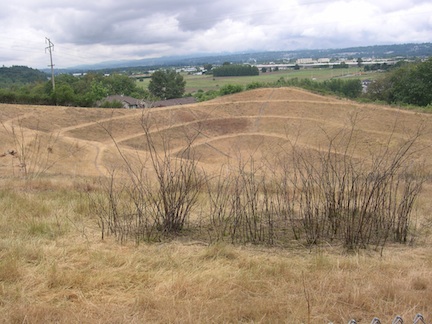
Sea Tac, Washington. (Photo: C. Lanzl)
Dr. Dieta Sixt
Our work at the Urban Culture Institute is guided by a belief in the potential for art in the public realm to create unforgettable and inspiring experiences, to be the beginning of a conversation that changes the way we think about and interact with the world around us.
Our fascination with the Exhibition Ends of the Earth Land Art to 1974, first exhibited at Museum of Contemporary Art, Los Angeles and shown at Haus der Kunst in Munich, Germany through January 20, 2013, is one of these moments.
We wish to encourage critical reflection to inform and improve methods of understanding contemporary art internationally and land art or earth art more specifically. This drives our commitment to explore ideas through projects of our regional and international peers.
We welcome your reactions, comments, your voice.
"Ends of the Earth and Back" , the catalogue essay by Philipp Kaiser and Miwon Kwon (Ends of the Earth, p. 17-31), reads like a manifesto to the movement Land Art:
Many people will think that a museum exhibition on Land art is impossible. How can you bring monumental artworks
that are continuous with the earth in remote locations such as the deserts of Nevada, Utah or New Mexico into a gallery
space? What can you exhibit inside the museum other than photographs, drawings, videos, films and models –
supplementary or documentary materials that compared with the 'real' works 'out there,' seem so small, paltry and
inconsequential? Is it not going against the intentions of the artists and the very spirit of this kind of art to even try to stage
such an exhibition?[1]
Questions like the following set up parameters for divisive discussion around the topic of Earth Art or Land Art. The above named authors, certainly aware of this discourse maintain that their focus on these issues are in general issues concerned with the field of contemporary art.
In recent years similar questions have been posed with regard to exhibitions of Performance and Body art [...]. Thus the
task of organizing ’Ends of the Earth’ has not only involved the apparent physical and conceptual improbability of presenting
Land art in a museum setting – it has also meant facing the more profound methodological and structural problems that
arise from the awkward meeting of institutions like museums, which are dedicated to the collection, preservation, and
presentation of art [...]. [2]
Indigenous to the Land art system and particularly what is on view in Munich, Germany offers a tribute to all participating and non-participating international artists from around the world, including a selection who proposed projects that remained proposals.
What is on view are artworks and not merely documentation. This is the provocative statement of the exhibition. As far as the Munich audience is concerned, the generation of under 25 have been roused and are flocking to the exhibition, if only to understand the historical place of the media in the exhibition, central to the issues of Land art. The media have been given a new meaning in the social media history of younger generations. Seize the moment and rediscover land shaped by artists.
[1] Ends of the Earth, p. 17.
[2] Ends of the Earth, p. 17.
 RSS Feed
RSS Feed